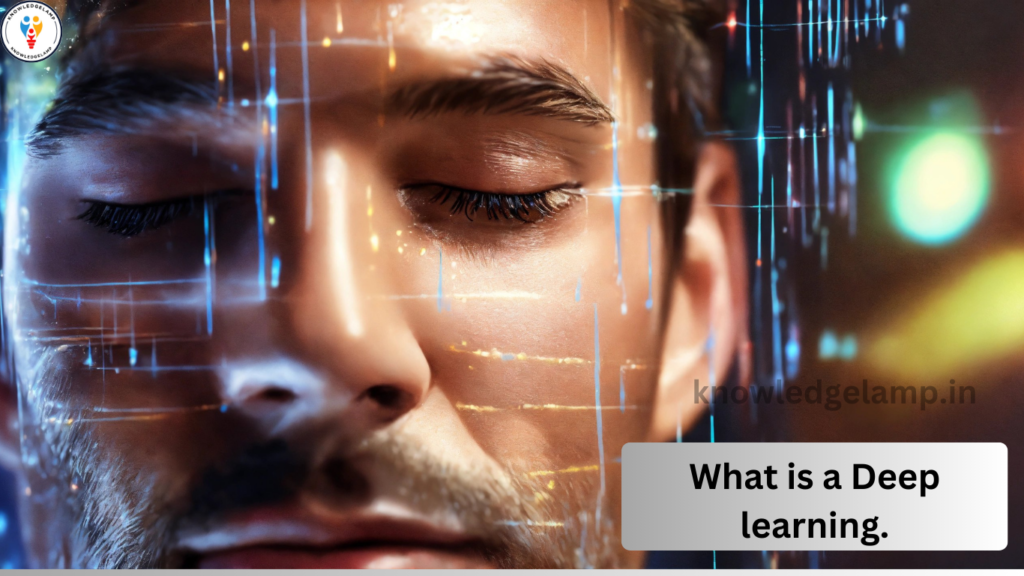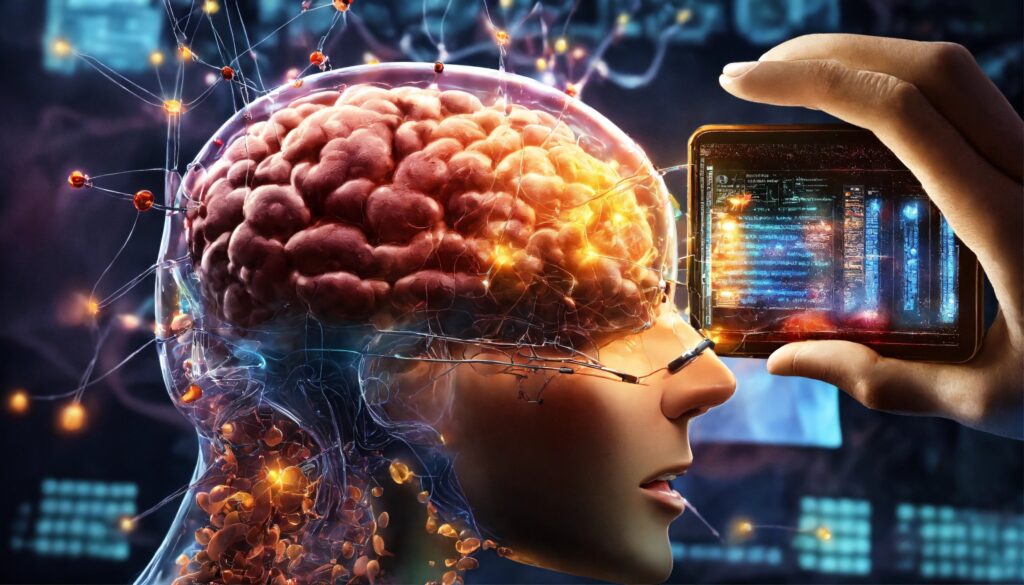
Deep learning is a subset of machine learning, which in turn is a subset of artificial intelligence (AI). It is a class of algorithms inspired by the structure and function of the human brain, specifically in its ability to learn and make decisions from data.
In traditional machine learning, the algorithms are explicitly programmed to perform a task based on provided data. In contrast, deep learning algorithms attempt to learn features and representations directly from raw data. They achieve this through the use of artificial neural networks with many layers (hence the term “deep”), which allows them to automatically discover intricate patterns and relationships within the data.
Deep learning has gained significant attention and popularity due to its remarkable performance in various tasks such as image and speech recognition, natural language processing, and even playing strategic games like Go. Some common deep learning architectures include convolutional neural networks (CNNs) for image processing, recurrent neural networks (RNNs) for sequence data, and transformers for natural language processing tasks.
History of deep learning.
The history of deep learning can be traced back to the 1940s, with the development of the first artificial neural networks (ANNs). Here’s a brief overview of key milestones in the history of deep learning:
1940s-1950s:- The origins of artificial neural networks date back to this period, with the work of Warren McCulloch and Walter Pitts, who proposed a mathematical model of a neuron. This model formed the foundation for early neural network research.
1960s-1970s:- Significant progress was made during this period in developing neural network models and algorithms. Notable contributions include the perceptron algorithm by Frank Rosenblatt, which laid the groundwork for training neural networks.
1980s-1990s:- Despite initial enthusiasm, interest in neural networks waned due to limitations in computational power, data availability, and theoretical understanding. This period is often referred to as the “AI winter.”
2000s:- Deep learning experienced a resurgence with advancements in computational resources, availability of large datasets, and improvements in training algorithms. Notable developments during this period include Geoff Hinton’s work on deep belief networks and the introduction of the backpropagation algorithm for training deep neural networks.
2010s:- Deep learning saw explosive growth and widespread adoption in various domains, fueled by breakthroughs in algorithms, hardware acceleration (such as GPUs), and access to big data. Convolutional neural networks (CNNs) gained prominence in computer vision tasks, while recurrent neural networks (RNNs) and long short-term memory (LSTM) networks revolutionized natural language processing and sequence modeling.
2012:- The ImageNet Large Scale Visual Recognition Challenge (ILSVRC) was won by a deep convolutional neural network called AlexNet, marking a significant breakthrough in computer vision using deep learning techniques.
2014:- Google Brain team’s development of deep learning algorithms for speech recognition significantly improved the accuracy of voice recognition systems.
2016:- AlphaGo, a computer program developed by DeepMind (a subsidiary of Alphabet Inc.), defeated the world champion Go player, Lee Sedol, showcasing the power of deep reinforcement learning in mastering complex games.
2018:- Transformer architecture, introduced in the paper “Attention is All You Need” by Vaswani et al., revolutionized natural language processing (NLP) tasks, leading to the development of models like BERT and GPT (Generative Pre-trained Transformer).
2020s:- Deep learning continues to evolve rapidly, with ongoing research focusing on improving model efficiency, interpretability, and robustness, as well as expanding its application to new domains such as healthcare, finance, and autonomous vehicles.
Why is deep learning important?
Deep learning is important for several reasons:-
Powerful Pattern Recognition:- Deep learning algorithms can automatically learn intricate patterns and representations from data, enabling them to solve complex problems across various domains such as computer vision, natural language processing, and speech recognition.
Handling Big Data:- With the exponential growth of data, traditional methods struggle to analyze and extract meaningful insights. Deep learning excels in processing large datasets efficiently and extracting valuable information from them.
Advancements in Technology:- Deep learning has led to significant advancements in technology, driving innovations in fields like autonomous vehicles, healthcare, finance, and robotics. It has enabled breakthroughs in areas such as image recognition, language translation, and medical diagnosis.
Improving Decision-Making:- Deep learning models can make accurate predictions and decisions based on the learned patterns from data. This capability is invaluable in various applications, including personalized recommendations, fraud detection, and risk assessment.
Automation and Efficiency:- By automating tasks that traditionally required human intervention, deep learning enhances efficiency and productivity. It enables businesses to automate processes, optimize operations, and streamline workflows.
Driving Scientific Research:- Deep learning facilitates scientific research by enabling scientists to analyze complex datasets, simulate phenomena, and make predictions in fields like astronomy, genomics, and climate science.
Addressing Societal Challenges:- Deep learning contributes to addressing societal challenges by improving healthcare outcomes, enhancing public safety, and tackling environmental issues. It plays a crucial role in developing solutions for healthcare diagnostics, disaster response systems, and climate modeling.
There are several types of deep learning architectures, each designed to address specific tasks and challenges. Some common types of deep learning include:
Convolutional Neural Networks (CNNs):- CNNs are primarily used for image recognition and computer vision tasks. They consist of multiple layers of convolutional filters that extract hierarchical features from input images, followed by pooling layers to reduce spatial dimensions and fully connected layers for classification.
Recurrent Neural Networks (RNNs):- RNNs are suitable for sequential data processing tasks such as time series prediction, natural language processing (NLP), and speech recognition. They have connections between neurons that form directed cycles, allowing them to retain information over time.
Long Short-Term Memory Networks (LSTMs):- LSTMs are a specialized type of RNN designed to address the vanishing gradient problem. They use memory cells and gating mechanisms to selectively retain or forget information over long sequences, making them effective for tasks requiring long-range dependencies and memory retention.
Generative Adversarial Networks (GANs):-GANs consist of two neural networks, a generator and a discriminator, trained adversarially to generate realistic data samples. They are used for generating synthetic images, videos, and other types of data, as well as for data augmentation and image-to-image translation tasks.
Autoencoders:- Autoencoders are neural networks trained to reconstruct input data from a compressed representation, called the latent space. They are used for dimensionality reduction, feature learning, and data denoising tasks.
Transformers:- Transformers are attention-based architectures originally developed for NLP tasks. They eschew recurrent connections in favor of self-attention mechanisms, allowing them to capture dependencies between different parts of the input sequence more efficiently. Transformers have achieved state-of-the-art performance in various NLP tasks such as language translation, text generation, and sentiment analysis.
Deep Reinforcement Learning (DRL):- DRL combines deep learning with reinforcement learning principles to enable agents to learn optimal behavior by interacting with an environment. It has been successful in training agents to play complex games, navigate environments, and solve sequential decision-making problems.

deep learning image.
Getting Started with Deep Learning.
Getting started with deep learning can seem daunting, but with the right resources and approach, it can be an exciting journey. Here’s a step-by-step guide to help you begin your deep learning journey
Learn the Basics of Python:
Python is the most commonly used programming language for deep learning. Start by learning the basics of Python programming, including data types, control structures, functions, and libraries such as NumPy and Pandas for numerical computing and data manipulation.
Understand Linear Algebra and Calculus:
Deep learning involves a lot of mathematical concepts, particularly linear algebra and calculus. Familiarize yourself with concepts such as matrices, vectors, derivatives, and gradients, as they form the foundation of many deep learning algorithms.
Explore Machine Learning Fundamentals:
Before diving into deep learning, it’s essential to understand the basics of machine learning, including supervised learning, unsupervised learning, and reinforcement learning. Learn about common machine learning algorithms and techniques such as regression, classification, clustering, and dimensionality reduction.
Study Neural Networks:
Neural networks are the building blocks of deep learning. Learn about the structure and functioning of neural networks, including different types of layers (e.g., dense, convolutional, recurrent), activation functions, loss functions, and optimization algorithms (e.g., gradient descent, Adam).
Choose a Deep Learning Framework:
There are several deep learning frameworks available, such as TensorFlow, PyTorch, Keras, and MXNet. Choose one based on your preferences and requirements. TensorFlow and PyTorch are the most popular choices and offer extensive documentation and community support.
Experiment and Iterate:
Deep learning is a highly iterative process. Experiment with different architectures, hyperparameters, and techniques to see what works best for your problem. Don’t be afraid to make mistakes—learning from failures is an essential part of the learning process.
Stay Updated:
Deep learning is a rapidly evolving field, with new research papers, techniques, and frameworks being released regularly. Stay updated with the latest developments by reading research papers, following blogs and forums, and attending conferences and workshops.
Join the Community:
Join online communities such as forums, social media groups, and meetups to connect with other deep learning enthusiasts, share knowledge, and seek help when needed. The deep learning community is vibrant and supportive, so don’t hesitate to ask questions and collaborate with others.
Success Stories in Deep Learning.
There have been numerous success stories in deep learning across various fields, demonstrating the transformative impact of this technology. Here are some notable examples:
Image Recognition and Computer Vision: Deep learning has revolutionized image recognition tasks, achieving human-level or even superhuman performance in some cases. For instance, in 2012, AlexNet, a deep convolutional neural network, won the ImageNet Large Scale Visual Recognition Challenge (ILSVRC) with a significant margin, marking a breakthrough in computer vision. Since then, deep learning techniques like CNNs have been widely adopted in applications such as object detection, facial recognition, medical imaging, and autonomous driving.
Natural Language Processing (NLP): Deep learning has led to significant advancements in natural language understanding and generation tasks. Examples include Google’s BERT (Bidirectional Encoder Representations from Transformers), which achieved state-of-the-art results on various NLP benchmarks by pretraining transformer-based models on large text corpora. Similarly, OpenAI’s GPT (Generative Pre-trained Transformer) models have demonstrated impressive capabilities in tasks like text completion, summarization, and translation.
Healthcare: Deep learning has shown promise in improving healthcare outcomes through applications such as medical image analysis, disease diagnosis, personalized treatment planning, and drug discovery. For instance, researchers have developed deep learning models capable of detecting diseases like cancer, diabetic retinopathy, and Alzheimer’s disease from medical images with high accuracy, enabling early diagnosis and intervention.
Autonomous Vehicles: Deep learning plays a crucial role in the development of autonomous vehicles, enabling them to perceive and navigate their environment effectively. Companies like Tesla, Waymo, and Uber are leveraging deep learning techniques to develop self-driving cars capable of recognizing objects, pedestrians, and traffic signs, and making real-time driving decisions based on sensory data from cameras, lidar, and radar sensors.
Finance: Deep learning is increasingly being used in financial services for tasks such as fraud detection, risk assessment, algorithmic trading, and credit scoring. Deep learning models can analyze large volumes of financial data, detect anomalies or fraudulent activities, and make predictions about market trends and investment opportunities with high accuracy, helping financial institutions optimize decision-making processes and reduce operational risks.
Future Trends in Deep Learning.
The field of deep learning is constantly evolving, and several trends are shaping its future direction. Here are some key future trends in deep learning:
Efficiency and Scalability: Future deep learning models will focus on improving efficiency and scalability to handle increasingly large datasets and complex tasks. This includes developing lightweight architectures, optimizing algorithms for distributed computing, and leveraging hardware accelerators like TPUs (Tensor Processing Units) and specialized AI chips.
Self-Supervised Learning: Self-supervised learning is emerging as a promising approach for training deep learning models without requiring labeled data. By learning from the inherent structure of the data itself, self-supervised learning enables models to generalize better and achieve higher performance on downstream tasks. This trend is expected to gain momentum in areas like natural language processing and computer vision.
Multimodal Learning: Multimodal learning involves processing and integrating information from multiple modalities, such as text, images, audio, and video. Future deep learning models will focus on multimodal representations to enable more comprehensive understanding and interaction with the real world. This trend has applications in areas like multimedia analysis, robotics, and augmented reality.
Explainable AI (XAI): As deep learning models become more complex and pervasive, there is a growing need for transparency and interpretability. Explainable AI (XAI) techniques aim to make deep learning models more understandable and interpretable by humans, enabling users to trust and verify their decisions. XAI will play a crucial role in domains like healthcare, finance, and autonomous systems, where interpretability is critical for decision-making.
Continual Learning: Continual learning involves the ability of deep learning models to learn and adapt continuously over time, without forgetting previously acquired knowledge. Future deep learning systems will focus on lifelong learning capabilities to handle evolving environments, new tasks, and changing data distributions. This trend is essential for applications like personalization, adaptive systems, and autonomous agents.
Federated Learning: Federated learning is a distributed machine learning approach where training data remains decentralized across multiple devices or edge devices, and model updates are aggregated centrally. This enables privacy-preserving and collaborative learning while leveraging the collective knowledge from diverse sources. Federated learning will become increasingly important in scenarios like IoT (Internet of Things), mobile devices, and edge computing.
Domain-Specific Architectures: As deep learning applications become more specialized and domain-specific, there will be a rise in the development of custom architectures tailored to specific tasks and industries. Domain-specific architectures optimize performance, efficiency, and resource utilization for targeted applications, leading to breakthroughs in areas like healthcare, autonomous vehicles, and scientific research.
Deep Learning in Everyday Life.
Deep learning has become an integral part of our everyday lives, impacting various aspects of society, technology, and personal experiences. From the smartphones we use to the services we rely on, deep learning algorithms play a significant role in shaping our interactions with the world. Here are some examples of how deep learning is prevalent in everyday life:
Personalized Recommendations: Deep learning powers recommendation systems used by online platforms like Netflix, Amazon, and Spotify to suggest personalized content based on users’ preferences, browsing history, and behavior patterns.
Voice Assistants: Voice assistants like Siri, Google Assistant, and Alexa utilize deep learning techniques for speech recognition, natural language understanding, and response generation, enabling users to interact with devices through voice commands.
Image Recognition: Deep learning enables image recognition capabilities in applications like social media, e-commerce, and surveillance systems, allowing users to search, tag, and categorize images automatically.
Language Translation: Deep learning models like Google Translate use neural machine translation techniques to translate text between different languages accurately and efficiently, facilitating communication and cross-cultural exchange.
Healthcare Diagnostics: Deep learning algorithms are used in medical imaging for tasks such as diagnosing diseases from X-rays, MRIs, and CT scans, assisting healthcare professionals in early detection and treatment planning.
Autonomous Vehicles: Deep learning powers the perception, decision-making, and control systems of autonomous vehicles, enabling them to navigate roads safely, recognize objects, and make real-time driving decisions.
Fraud Detection: Financial institutions leverage deep learning models for fraud detection and prevention by analyzing transaction data, detecting anomalous patterns, and identifying potential fraudulent activities in real-time.
Conclusion:
Deep learning has transformed the way we interact with technology and has led to significant advancements in various fields, from healthcare and finance to entertainment and transportation. Its ability to learn from data and make intelligent decisions has unlocked new opportunities for innovation and productivity. As deep learning continues to evolve, it holds the potential to address complex challenges, improve quality of life, and drive economic growth. However, it also raises important ethical, privacy, and societal implications that need to be addressed responsibly. By harnessing the power of deep learning while ensuring ethical and inclusive deployment, we can create a future where AI enriches our lives and empowers individuals and communities.
FAQs (Frequently Asked Questions):
What is deep learning?
Deep learning is a subset of machine learning that uses artificial neural networks with multiple layers to automatically learn representations from data, enabling computers to perform tasks such as image recognition, natural language processing, and decision-making.
How does deep learning work?
Deep learning algorithms learn hierarchical representations of data by passing it through multiple layers of interconnected neurons. These layers extract features from raw input data, enabling the model to learn complex patterns and relationships.
What are some popular deep learning frameworks?
Popular deep learning frameworks include TensorFlow, PyTorch, Keras, and MXNet. These frameworks provide tools and libraries for building, training, and deploying deep learning models efficiently.
What are some challenges in deep learning?
Challenges in deep learning include overfitting, vanishing gradients, interpretability, scalability, and ethical concerns such as bias and fairness. Addressing these challenges requires advances in algorithms, infrastructure, and regulatory frameworks.
How can I get started with deep learning?
To get started with deep learning, you can learn Python programming, study linear algebra and calculus, understand basic machine learning concepts, explore neural networks, and experiment with deep learning frameworks through hands-on projects and tutorials available online.
